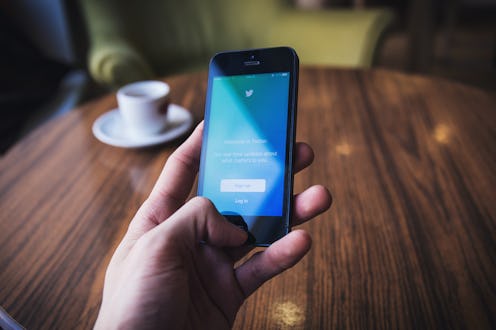
In an age where people can literally post anything they want on the internet, often without repercussions, it's become all too common for outrageous headlines to spread — even if the stories behind them aren't actually real. Luckily, there's a new way to distinguish legit journalism from the phony: The @SavedYouATrick Twitter account is working to fight the fake news epidemic by verifying stories and social media posts and identifying when they're false.
And fake news really is an epidemic. While it's pretty cool that there are social media initiatives entirely dedicated to fighting misinformation, the fact that there is more baloney on the internet than my middle school sandwiches is a huge problem. But how? How is it that it's fooling so many? "People fall for fake news because they fit into readers' pre-existing narratives about politics or how the world works," writes Jake Beckman, creator of @SavedYouATrick, in an email to Bustle. "Fake news is just another way to say that you're being intentionally lied to, and that's dangerous because of how easily and quickly lies can spread on the Internet."
If Beckman's name sounds familiar, it's probably because you know him as the guy who also runs @SavedYouAClick. With @SavedYouAClick calling out clickbait, or articles with enticing headlines and blurbs that seduce you into clicking on the link, @SavedYouATrick seems like a natural extension of the original. Misinformation has spread like wildfire over the past several months, moving far beyond the occasional fake celebrity deaths and conspiracy theories which have cropped up periodically pretty much since the internet's inception. During the last few weeks of the U.S. presidential election, fake news was actually shared more on Facebook than actual news stories, according to BuzzFeed. And we're not talking about satire, mind you; people were sharing real hoaxes with their friends — articles with incorrect headlines that were designed to make you believe they're true.
Fake news comes in all different forms, such as made-up articles on fake news websites or screenshots of fake tweets or Facebook posts. People have gotten clever over time; although you would think that they'd have better things to do than, say, Photoshop an image just to provide "evidence" in an online argument, the practice of doing so has become increasingly common. It's hard to pinpoint why some people go so far as to make stuff up on purpose — but Beckman has a theory: "Fake news sites run lots of ads, so running a high-traffic fake news site would probably make you quite a bit of money," he writes. "Since interesting information is a scarcity in our media ecosystem, it makes sense that people might just make up their own stories to get clicks and shares."
As a journalist working in a digital-first media space, I find it extremely troublesome that fake news has become such a major social media phenomenon that it's actually spinning out of control. Good journalists fact-check, follow up with their sources, and admit when they get something wrong. I promise that the vast majority of journalists are not out to "get" you or purposely lead you astray.
And here's one of the biggest issues with fake news: When people who are bombarded with stories like this realize they're untrue, it makes them distrust the media industry even more. This is problematic because, no matter what you might think about "the media," journalism is essential to democracy and watchdog reporting helps to maintain checks and balances in all sectors. By sharing what looks like a news story, but in reality is just a piece of fiction written by an internet troll, we aren't able to focus on true stories that actually matter. It prevents us from making any real change.
So the next time you click on a link and it leads you to a questionable article or a screenshot of a social media post, check @SavedYouATrick to see if Beckman's debunked it already (you can search the account's tweets using snapbird.org). Or fact-check it yourself using Google search tactics or the Internet Archive. You never know what you may or may not find.
Images: freestocks.org/Unsplash